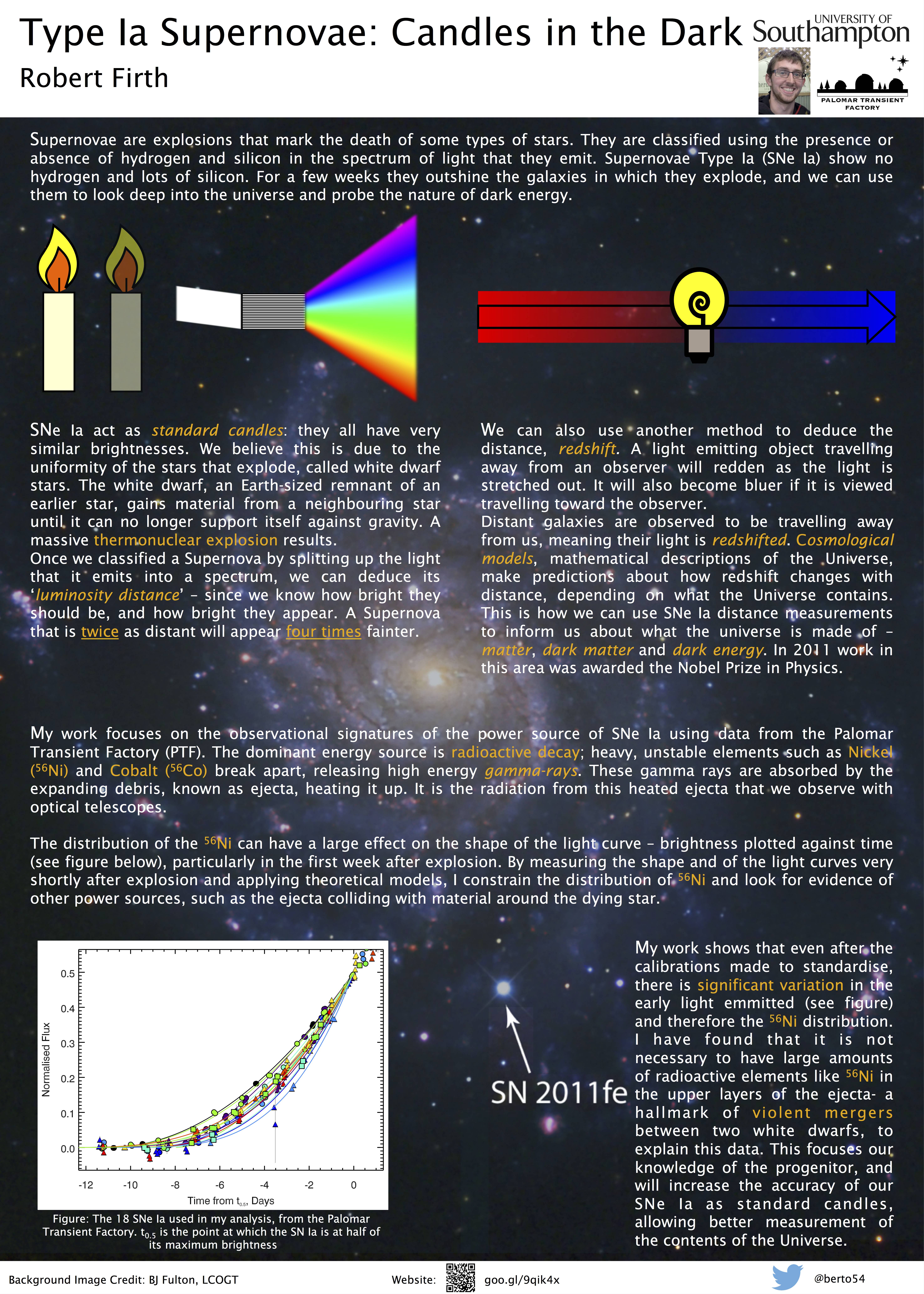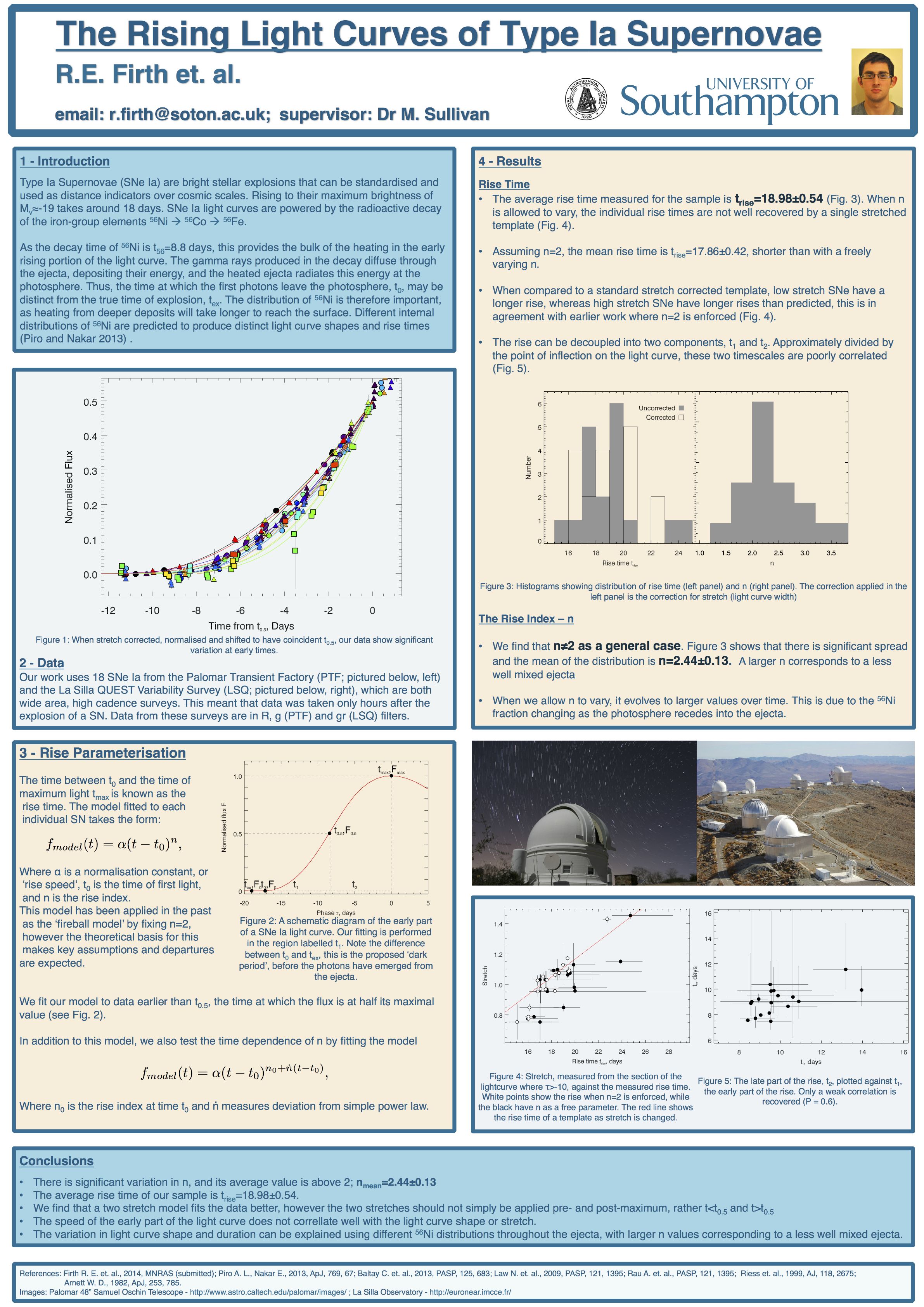Publications
On this page I have collected the title, abstracts and links (where possible) to my published work, both as a first author and as a contributing author, and presentations, both talks and posters. If you have any questions about me work, please drop me an email on science@robertfirth.co.uk, or head to the contact page for more ways to get in touch.
PhD Thesis
'Explosions in the Sky: The Physics of Type Ia Supernovae from Large Astrophysical Datasets'
R. E. Firth
Supervisor: Prof. M. Sullivan
University of Southampton, Department of Physics and Astronomy
PhD awarded: January 2017
Abstract
This thesis studies type Ia supernovae (SNe Ia) discovered by the Palomar Transient Factory (PTF). We use this large, high--quality imaging and spectroscopic dataset to analyse the very earliest part of the SN Ia light curve, probing the ejecta structure, the post–maximum light curve, the $^{56}Ni~$distribution, and the utility of SNe Ia as standard candles at different wavelengths.
The high cadence of PTF makes it capable of studying SNe Ia at very early times, as they rise just after explosion. In this thesis we use 18 SNe Ia from PTF and the La Silla-QUEST variability survey (LSQ) to measure the time between first light, $t_0$, and maximum light ($t_{rise}$), and rise index ($n$), where $f= (t-t_0)^{n}$. We find that $n$ shows significant variation ($1.48\leq n \leq3.70$), and has a mean value $\bar{n}=2.44\pm0.13$, inconsistent with a simple fireball model ($n=2$) at $3\sigma$. We calculate an average \( t_{rise} \) of our sample $t_{rise}=18.98\pm0.54$~days, and find that the variation seen in $t_{rise}$ and $n$ is principally driven at the very earliest epochs.
We use a further sample of 31 PTF SNe Ia to explore the diversity of the post-maximum light curve in $R$--band, as the emission at these phases is linked to the same driver of variation -- the distribution of \nickel{}~ through the ejecta. By modelling the shoulder on the light curve we quantify the strength and timing of this feature. We find that the timing of the additional emission is correlated with light curve width, but that the duration is not. We also find that the prominence of the gaussian, relative to its peak, is inversely correlated with the light--curve width. We interpret this as the impact of intermediate mass element spectral features dominating over those of iron peak elements.
Having explored the physics that governs these objects, we turn to the primary motivation for studying SNe Ia -- their use as standardisable candles. We consider 60 SNe Ia in three filters, $B$, $R$ and $i$, constructing hubble diagrams for each. We find that the magnitude of the corrections for light curve width and SN colour decreases as a function of wavelength, and that SNe Ia in $i$--band do not need correction for light curve width. We also find that the colour law observed for our sample is not consistent with the standard Milky--Way extinction law, with $R_V = 3.1$. Finally, we find that SNe Ia in $i$ are superior standardisable candles to $B$--band, and that they are overall the best in $R$. This sample is well placed to anchor future high--redshift rest--frame $i$--band cosmological studies.
Articles
First Author Papers
'The Rising Light Curves of Type Ia Supernovae'
R. E. Firth, M. Sullivan, A. Gal-Yam, D. A. Howell, K. Maguire, P. Nugent, A. L. Piro, C. Baltay, U. Feindt, E. Hadjiyksta, R. McKinnon, E. Ofek, D. Rabinowitz, E. S. WalkerMNRAS, 446, 3895-3910, 2015. arXiv: 1411.1064
Abstract
Co-Author Papers
'Early observations of the nearby Type Ia supernova SN 2015F'
R. Cartier, M. Sullivan, R. E. Firth, G. Pignata, P. Mazzali, K. Maguire, M. J. Childress, I. Arcavi, C. Ashall, B. Bassett, S. M. Crawford, C. Frohmaier, L. Galbany, A. Gal-Yam, G. Hosseinzadeh, D. A. Howell, C. Inserra, J. Johansson, E. K. Kasai, C. McCully, S. Prajs, S. Prentice, S. Schulze, S. J. Smartt, K. W. Smith, M. Smith, S. Valenti, D. R. Young,MNRAS, 464, 4476-4494, 2017. arXiv: 1609.04465
Abstract
'A search for an optical counterpart to the gravitational wave event GW151226'
S. J. Smartt, K. C. Chambers, K. W. Smith, M. E. Huber, D. R. Young, T. -W. Chen, C. Inserra, D. E. Wright, M. Coughlin, L. Denneau, H. Flewelling, A. Heinze, A. Jerkstrand, E. A. Magnier, K. Maguire, B. Mueller, A. Rest, A. Sherstyuk, B. Stalder, C. W. Stubbs, A. S. B. Schultz, J. Tonry, C. Waters, R. J. Wainscoat, M. Della Valle, M. Dennefeld, G. Dimitriadis, R. E. Firth, M. Fraser, C. Frohmaier, A. Gal-Yam, J. Harmanen, E. Kankare, R. Kotak, M. Kromer, I. Mandel, J. Sollerman, B. Gibson, N. Primak, M. WillmanApJL, 827, L40, 2016. arXiv: 1606.04795
Abstract
Presentations
Posters
'Type Ia Supernovae: Candles in the Dark' - 2014-10-01
Presented at the 2014 STAG Public Lecture by Physics Nobel Laureate Prof. Gerard 't Hooft
'The Rising Light Curves of Type Ia Supernovae' - 2014-08-11/14
Presented at 2014 CAASTRO Annual Scientific Conference - "Supernovae in the Local Universe: Celebrating 10,000 Days of Supernova 1987A" in Coffs Harbour, NSW, Australia

